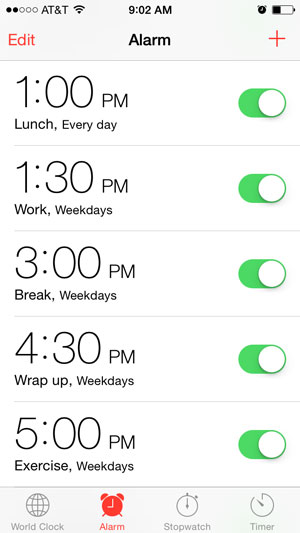Sure, alarms are great for getting you out of bed in the morning, but you can use them for a whole lot more. You can schedule an alarm to go off at anytime, for any reason you choose.
You can use alarms to build better creative habits, like setting an alarm to remind you to write in your journal at a certain time each day. Give it a few days, and like Pavlov’s dog, you’ll start to salivate on the ringing of the bell, or in this case get to writing when the Apex alarm sounds on your iPhone.
After you follow through, acting on this trigger a number of times, it will become reflexive. That habit will get sticky and become part of your everyday routine. You’ll get excited that you created a new, positive habit and self-directed change. It’s powerful stuff!
You can design your actions—orchestrate them as you see fit.
You have these triggers at your fingertips. You can set an alarm on your phone and start pushing yourself to take action. Let’s look at how, with some examples, as well as pitfalls to watch out for.
My iPhone Alarms
I have a number of alarms set on my iPhone and use them as triggers throughout my day.
It’s really helpful to use alarms as triggers to spur you to take action, especially when you’re trying to establish new habits or break old ones; change isn’t easy. Setting an ideal schedule, one that maximizes your creative output, can take some work.
I have my daily work schedule set as a series of alarms on my phone, which remind me of the structure of my workday, which is broken down into a series of 90 minute to two hour work sessions.
Here is an example of my afternoon alarms:

Notice that my afternoon has few work sessions. Time is limited, so when an alarm goes off it alerts me to get to it:
- 1:00PM an alarm on my phone goes off, I prep lunch and eat, and when the next alarm goes off on my phone at 1:30PM it alerts me to get back to work—now.
- I have a 90 minute work session after lunch, so I try to keep lunch short, or else I’m literally eating into my productivity. Also, long lunches make me lazy, so I do my best to avoid them.
- The next alarm goes off at 3:00PM, signaling me to take a quick break. I have another 90 minute work session up next, following this short break—minus the break time of course.
- Then a final afternoon alarm signals it’s time to wrap up. I set aside 30 minutes for the end of the day to organize my projects, send last minute emails, update my weekly schedule, and decide on my most important tasks (MITs) for tomorrow.
- Then another alarm goes off at 5:00 PM, spurring me to put on my biking gear and go ride 10K or so. Or go do anything active for about an hour, while I decompress from another (hopefully productive) day at work.
This is my ideal afternoon and what I’m aiming for. These alarms help me more consistently keep to this half of my work schedule everyday.
A Note on Flexibility
Changes habits is messy though. You may succeed some of time, but rarely will you add a new habit and hit it all the time. Keep in mind the point is progress.
I listed my ideal above, but the afternoon is the time that I’ve struggled most with being consistently creative. It’s often my lowest energy time of the day. There are all too many afternoons that I take a long lunch, or even nap through my 1:30PM to 3:00PM work session. Meetings might come up, I might get a horrible headache, or I might procrastinate on any number of things.
An alarms sounds and it helps spur me to action—reminding me to get to work. I don’t follow through every time, but more often than before using alarms. My success rate is up because of them. These little triggers have really helped. They’ve assisted me with making changes at other times of the day as well.
Whatever habit changes you’re struggling with, expect setbacks. If you’re having a particularly difficult time changing a habit, then try segmenting it down. Look at what small action you can focus on, that isn’t too difficult, something you can build positive, forward momentum with.
Maybe this week, focus on that first half hour after getting back to work from lunch. Or focus on eating a lighter lunch, so too much food doesn’t weight down your afternoon. Each tiny change you make will add up, if it becomes a regular, repeated habit. This week, I’ve been making a bit of progress with my end of day routine and with eating a healthier lunch.
Set an alarm to trigger an action you want to take daily, to help push the habit change you are trying to make.
Boom! Stack those Actions
Take a look at specific times of the day and activities you want to improve.
We’ve looked at afternoons, so let’s take a look at your morning routine. What would make your mornings more effective? What’s one change you could make to improve your morning—every morning? How might it work together with ten other tiny improvements? Stacking habits together is powerful!
You might struggle to get up at your desired time for a week, but then adjust to this new goal. Then the next week you work on changing your breakfast, and eat more creative brain food, than what you usually eat. Add in some meditation another week, morning journaling or drawing the next, and now you’re starting to stack together some significant habit changes. It may take a couple months to stack together an ideal morning routine, but little by little you can do it.
With just one change at a time, you can start to build an ideal routine. One that fires off from just one alarm on your iPhone.
Keep in mind that to make lasting change, it’s easier to change one or two habits at a time, as more than that is just plain difficult. You can only juggle so many changes in a week and make new habits stick long term.
Keep it simple. Make one tiny change at a time, for one week, or two weeks, until the habit feels ingrained and easy to do, then add another habit, until you build up a powerful routine.
I’ve transformed different times of my day with this approach, starting with my mornings, then working on my evening routine, and now I’m really focused on improving my afternoons (which is my lowest energy time, so toughest to tackle).
You can drastically change your creative output over time if you keep stacking your habits together.
Add Actions or Take Them Away
What your’e doing with this is designing your life, and ideally creating optimal habits to crush your creative work out the door. You’re designing your days.
In addition to adding new, positive habits, you can also use alarms to signal negative habits to stop doing. This is particularly helpful if you have a habit you’re trying to eliminate and you need an extra push while you dig into making that change.
I currently have a reminder on my phone that goes off at 7PM every night, that says “Stop eating.” I’m trying to take away all that nighttime snacking that’s pulling down my health.
I did get some unexpected social support with that habit as well. My son borrows my phone at night to watch Netflix cartoons. So, he comes out at 7PM every night to tell me that, “Dad, your phone says to stop eating.” Ha, great reminder!
Another thing to consider is how you organize your routines. Try out different times of the day for different actions and see how easy it is to accomplish them, and how these new habits effect everything else you’re trying to do. For example, I like exercising in the morning, but I found that it was taking energy away from my early morning creative writing time, so I moved it to early evenings. That worked much better for me and helps me ease from the end of my workday into my evening routine.
Figure out what works for you.
Beep! Beep! Take Action
Try setting one alarm today, to change one tiny, daily action. What do you want to accomplish?
- If you want to start work at a specific time every day, or every weekday, then set an alarm to remind you to do that.
- Or, maybe set alarms that signals the start and end of a work session.
- Or, set an alarm that triggers you to tackle your most difficult task of the day.
Add just one alarm-based action this week, for one change you want to make, run it as an experiment. See if you can take action for seven days in a row.
Tiny changes like this will add up over time, the key is to make them consistent—too stick with making one change until it’s permanent. Add enough of these types of changes over time and it will add up to whole new, productive routines.
Get to it! Put those alarms to work. Start designing your life to maximize your creative output.
Graphic Credit: Alarm designed by SuperAtic LABS from the Noun Project.


